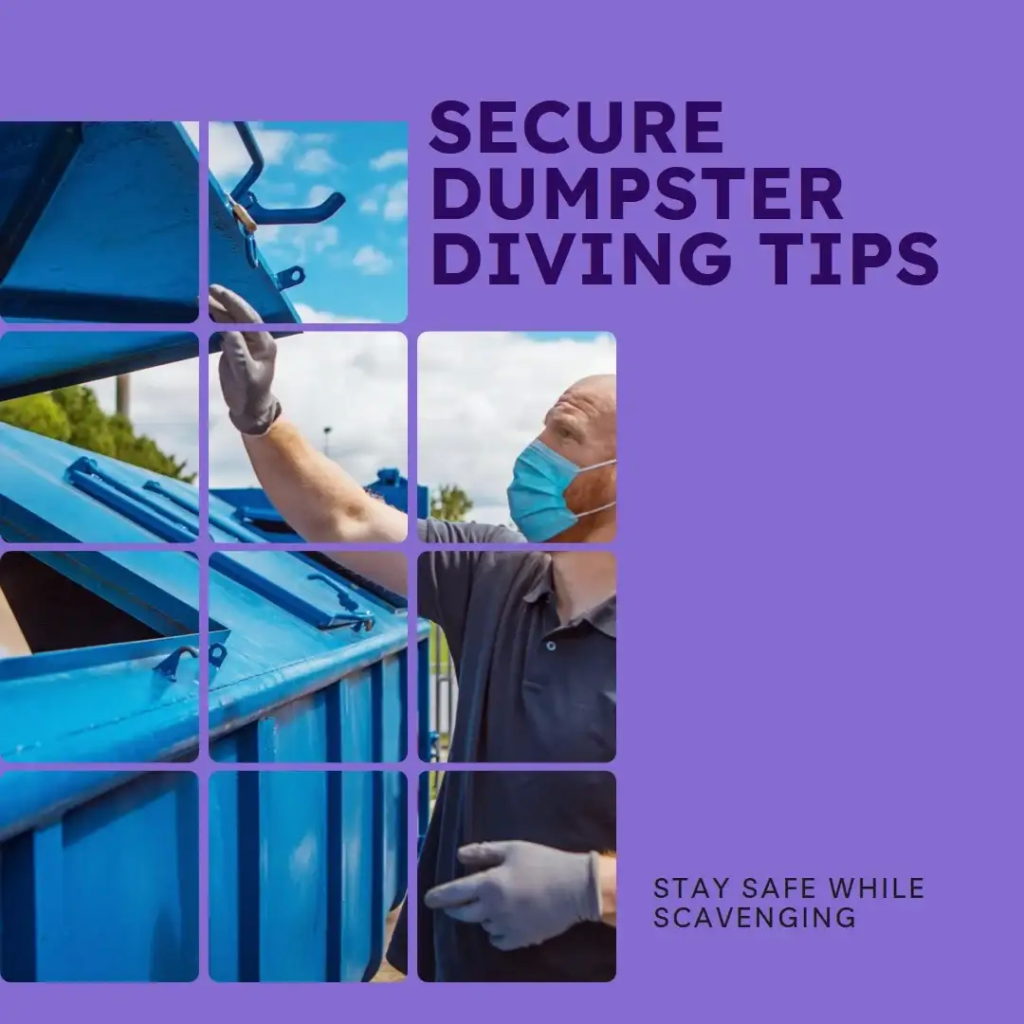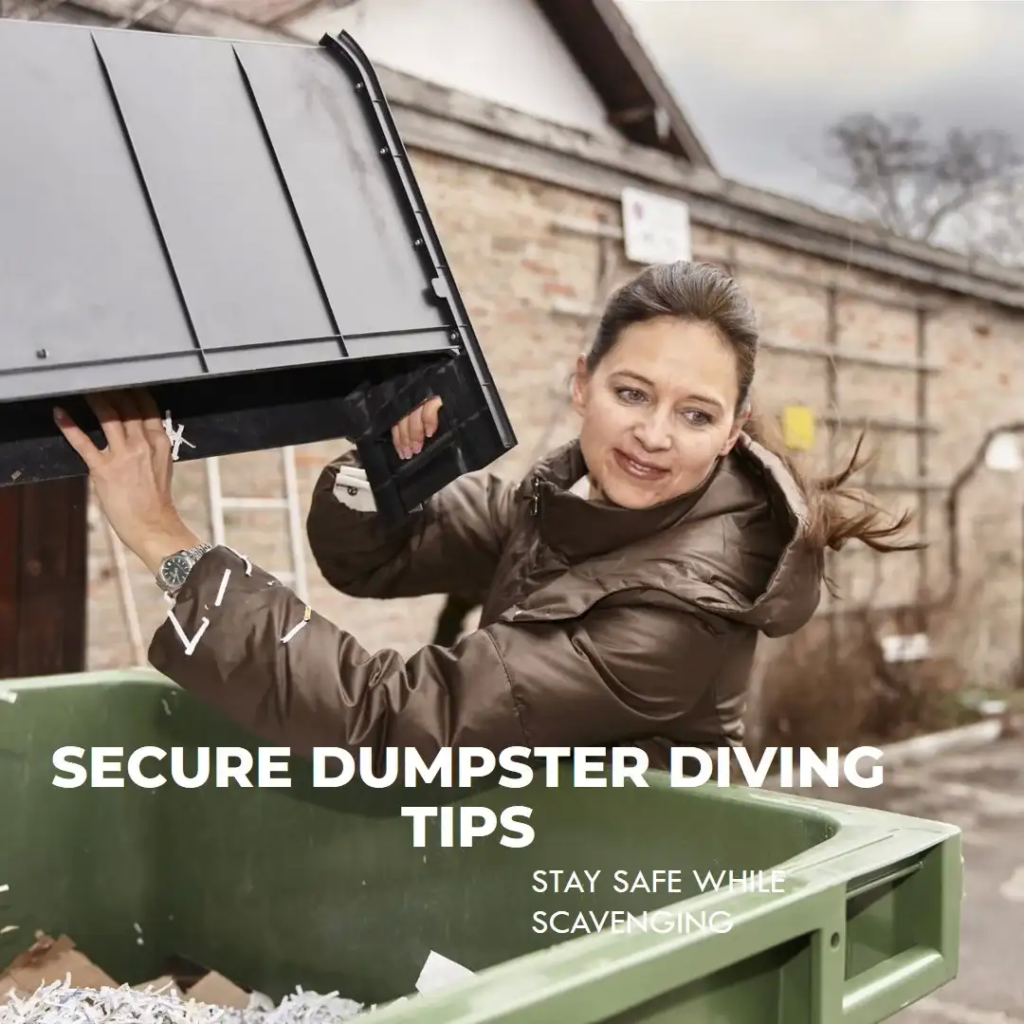Dumpster diving is the practice of searching through trash containers, such as dumpsters or trash bins, for discarded items that are still usable. People who engage in dumpster diving often seek out items like food, clothing, furniture, electronics, and other goods that can be salvaged or repurposed.
Why is Safety Important in Dumpster Diving?
While dumpster diving can be a way to find useful items and reduce waste, it is important to prioritize safety when engaging in this activity. There are several reasons why safety is important in dumpster diving:
- Physical hazards: Dumpsters can contain sharp objects, broken glass, or other debris that can cause injuries if not handled with care.
- Biohazards: Trash containers may contain hazardous materials, such as chemicals, biological waste, or expired medication, which can pose health risks if exposed to them.
- Structural instability: Dumpsters may not be stable or secure, and climbing in or around them can lead to accidents and injuries.
- Legal implications: Dumpster diving laws vary by location, and trespassing on private property or taking items without permission can result in legal consequences.
By prioritizing safety practices, such as wearing gloves and sturdy footwear, being cautious of potential hazards, and respecting property boundaries, individuals can reduce the risks associated with dumpster diving.
Prepare Yourself
Before engaging in dumpster diving, it is important to research and understand the laws and regulations regarding this activity in your local area. Dumpster diving laws vary from place to place, and it is crucial to know if there are any restrictions, permits, or legal implications involved. Familiarize yourself with the specific guidelines and ensure that you are not trespassing on private property or breaking any laws while dumpster diving.
Wear Protective Clothing and Equipment
To minimize the risks associated with dumpster diving, it is essential to wear protective clothing and equipment. This includes sturdy gloves to protect your hands from sharp objects or hazardous materials, as well as closed-toe shoes to prevent injuries from broken glass or other debris. Additionally, consider wearing long sleeves and pants to provide an extra layer of protection. Safety goggles can also be beneficial to shield your eyes from any potential hazards. By wearing the proper attire, you can reduce the chances of injuries or exposure to harmful substances while dumpster diving.
Choose the Right Location
When dumpster diving, it is important to choose the right location to ensure safety and legality. Here are some factors to consider when identifying safe areas:
| Factors | Safe Areas |
|---|---|
| Commercial Areas | Look for dumpsters in commercial areas like shopping centers or office complexes where businesses dispose of items. |
| Residential Areas | Some residential areas may have dumpsters near apartment complexes or student housing where people discard usable items. |
| Public Spaces | Public parks or recreational areas may have trash bins where people dispose of items that can still be salvaged. |
Avoid Private Property and Restricted Areas
It is crucial to avoid private property and restricted areas when dumpster diving. Trespassing on private property is illegal and can result in legal consequences. Additionally, some areas may have specific regulations or permits required for dumpster diving. Always respect property boundaries and abide by local laws and regulations to ensure a safe and legal experience..
Be Aware of Potential Dangers
When engaging in dumpster diving, it is important to be cautious of potential dangers. One such risk is encountering sharp objects and broken glass. These items can cause injuries, such as cuts or punctures, if not handled carefully. It is advisable to wear protective gloves and use tools like tongs or a grabber to minimize the risk of getting hurt. Always inspect the area around the dumpster for any hazardous materials before reaching inside.
Watch Out for Animals and Insects
Another potential danger to be aware of when dumpster diving is the presence of animals and insects. Trash bins and dumpsters can attract wildlife, such as raccoons, rats, or stray dogs, which may pose a threat if they feel threatened or become aggressive. Additionally, insects like bees, wasps, or spiders could be lurking around discarded items. To avoid encounters with animals and insects, it is recommended to make noise, carry a flashlight, and be vigilant while dumpster diving.

Practice Safe Techniques
When engaging in dumpster diving, individuals should prioritize their safety by using a flashlight to illuminate the surrounding area. This can help spot potential hazards, such as sharp objects or broken glass, before reaching inside. It is also advisable to wear protective gloves to minimize the risk of cuts or punctures while rummaging through discarded items. By having a flashlight and gloves on hand, individuals can ensure better visibility and reduce the chances of getting injured.
Be Mindful of Noise and Visibility
To avoid attracting unwanted attention or causing suspicion, it is important to be mindful of noise levels while dumpster diving. Keeping noise to a minimum can prevent drawing the attention of security personnel or nearby residents. It is also crucial to consider visibility, especially at night. A good practice is to choose well-lit areas and have a cover story, such as looking for recyclables, in case someone questions the activity. By being cautious of noise and visibility, individuals can engage in dumpster diving with less risk of interference.
Practice Safe Techniques
When engaging in dumpster diving, individuals should prioritize their safety by using a flashlight to illuminate the surrounding area. This helps them spot potential hazards, such as broken glass or sharp objects, before reaching inside. It is advisable to wear protective gloves to minimize the risk of cuts or punctures while rummaging through discarded items. By having a flashlight and gloves on hand, individuals ensure better visibility and reduce the chances of getting injured.
Be Mindful of Noise and Visibility
To avoid attracting unwanted attention or suspicion, it is important to be mindful of noise levels during dumpster diving. Keeping noise to a minimum prevents drawing the attention of security personnel or nearby residents. It is crucial to consider visibility, especially at night. Choosing well-lit areas and having a cover story, like looking for recyclables, can help explain the activity if questioned. By being cautious of noise and visibility, individuals can engage in dumpster diving with less risk of interference.
Check Before You Dive
Before diving into a dumpster, it is crucial to inspect it for any potential hazards. Look for broken glass, sharp objects, or any other items that could cause injury. Make sure the area is well-lit, so you can properly see what’s inside the dumpster.
Avoid Trapped or Dangerous Items
When diving into a dumpster, it is important to be cautious about trapped or dangerous items. Avoid dumpsters with heavy or unstable loads that could collapse and cause harm. Be aware of any potential risks, such as hazardous materials or biological waste, and avoid those dumpsters. Safety should always be the number one priority when engaging in dumpster diving. So, make sure to thoroughly assess the dumpster before diving in and avoid any potential dangers.
Properly Dispose of Trash
Individuals should always practice respect for the dumpster and its surrounding area when engaging in dumpster diving. This means avoiding any unnecessary mess or damage to the dumpster itself, as well as the surrounding property. Cleaning up any trash that may have been displaced during the diving process is also important to maintain cleanliness and prevent littering. By showing respect for the dumpster and its surroundings, individuals can help maintain a positive image for the dumpster diving community.
Follow Proper Recycling Guidelines
When dumpster diving, it is essential to follow proper recycling guidelines to ensure that recyclable items are separated from non-recyclable trash. This not only helps protect the environment but also allows for more efficient recycling processes. Below is a simple table outlining some common items and their respective recycling categories:
| Item | Recycling Category |
|---|---|
| Glass bottles | Glass recycling |
| Plastic bags | Plastic recycling |
| Aluminum cans | Metal recycling |
| Cardboard | Paper recycling |
| Electronic devices | E-waste recycling |
By following these guidelines and properly separating recyclable materials, individuals can contribute to a more sustainable and eco-friendly practice of dumpster diving.

The Importance of Safety in Dumpster Diving
Individuals engaging in dumpster diving should always show respect for the dumpster and its surroundings, avoiding any unnecessary mess or damage. It is important to clean up any displaced trash to prevent littering and maintain cleanliness, helping to uphold a positive image for the dumpster diving community.
Follow Proper Recycling Guidelines
When engaging in dumpster diving, it is crucial to adhere to proper recycling guidelines. This means separating recyclable items from non-recyclable trash to promote environmental protection and efficient recycling processes. Some common items and their respective recycling categories include glass bottles (glass recycling), plastic bags (plastic recycling), aluminum cans (metal recycling), cardboard (paper recycling), and electronic devices (e-waste recycling). By following these guidelines, individuals contribute to a more sustainable and eco-friendly practice of dumpster diving.
Enjoying a Secure and Rewarding Experience
To ensure safety, it is advisable to go dumpster diving with a friend. Having a companion enhances the overall experience and provides assistance, lookout, and support during the activity.
Trust Your Instincts and Stay Alert
While dumpster diving, trust your instincts and stay alert. If something seems unsafe or suspicious, it is better to avoid it. Being aware of your surroundings ensures personal safety throughout the entire process.
Conclusion
In dumpster diving, safety should always be a priority. By respecting the dumpster and its surroundings, following proper recycling guidelines, and practicing personal safety tips, individuals can enjoy a secure and rewarding experience while contributing to a more sustainable and environmentally-friendly practice of dumpster diving.

Greetings, eco-conscious explorers! I am Arjun Bandari, a seasoned Dumpster Diving enthusiast with over a decade of expertise in uncovering hidden treasures amidst the discarded. My journey into this unconventional lifestyle began in New York, fueled by a passion for sustainability and a desire to challenge the norms of our throwaway culture.
With a bachelor’s in Enviromental Health and Safety, I seamlessly blend academic insights with practical experiences to navigate the world of Dumpster Diving. Over the years, I’ve become a recognized figure in the sustainable living community, sharing my discoveries and insights through workshops, community outreach, and various online platforms.
My commitment to promoting eco-friendly practices has garnered attention from local and regional media, earning me featured spots in publications that highlight the environmental impact of Dumpster Diving. As an advocate for responsible waste management, I have been honored with awards recognizing my contributions to the field.
In addition to my hands-on experiences, I’ve extended my reach through various published works, shedding light on the untapped potential within discarded items. Whether it’s repurposing furniture, salvaging electronics, or sharing practical tips for fellow Dumpster Diving enthusiasts, I am dedicated to inspiring a conscious and sustainable way of living.
Join me on this exciting journey as we redefine the narrative around waste, discover hidden gems, and collectively contribute to a greener, more sustainable future. Together, let’s dive into the world of Dumpster Diving and uncover the beauty beneath the surface of our disposable society.

